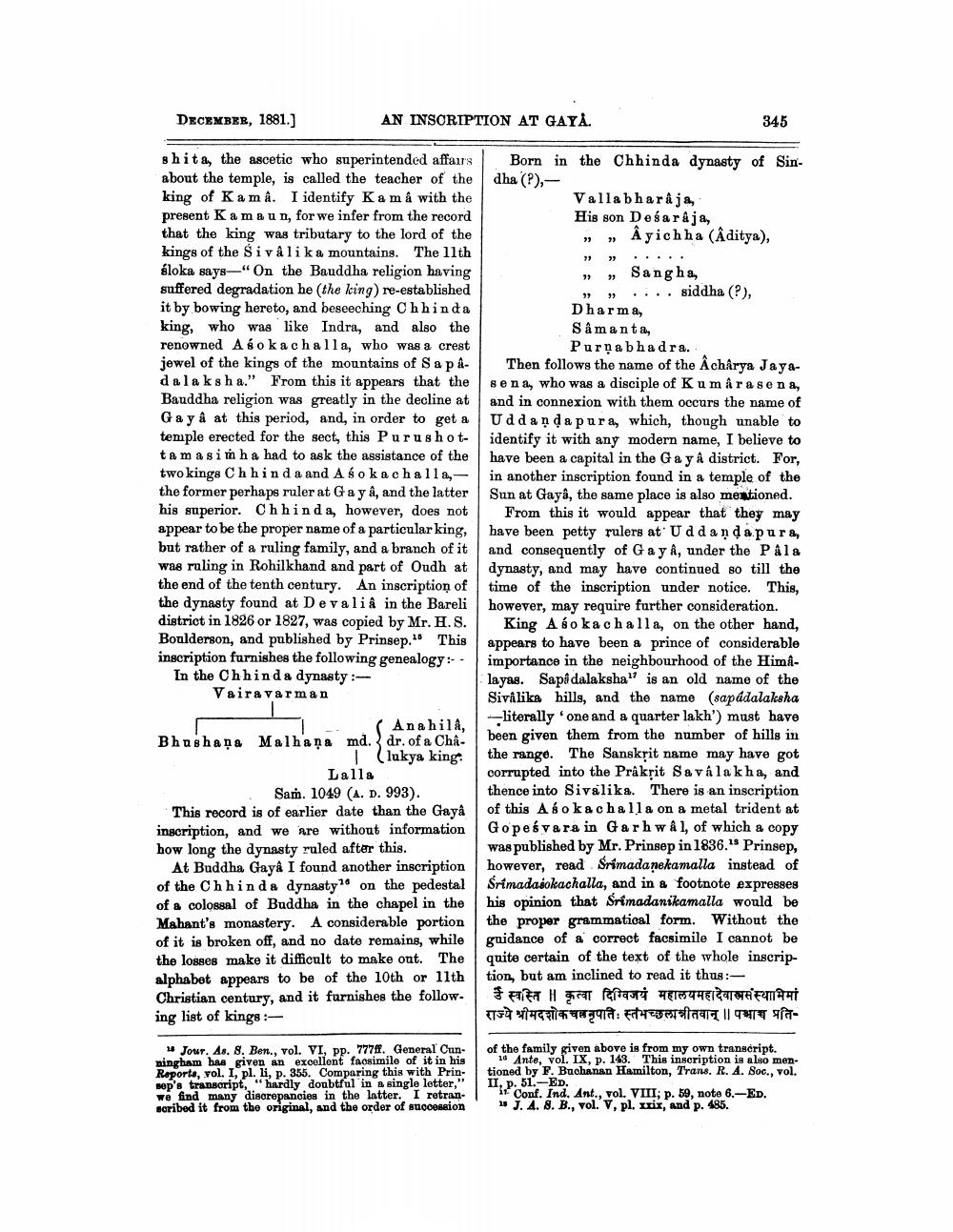________________
DECEMBER, 1881.)
AN INSCRIPTION AT GAYÅ.
345
Born in the Chhinda dynasty of Sindha ),
Vallabharaja His son Deśaraja, „ „ Âyichha (Aditya),
shita, the ascetic who superintended affair's about the temple, is called the teacher of the king of Kama. I identify Kam å with the present Kamau n, for we infer from the record that the king was tributary to the lord of the kings of the Sivå lika mountains. The 11th sloka says-"On the Bauddha religion having suffered degradation he (the king) re-established it by bowing hereto, and beseeching Chhinda king, who was like Indra, and also the renowned Asoka challa, who was a crest jewel of the kings of the mountains of Sa pa dala ksha." From this it appears that the
Bauddha religion was greatly in the decline at Ga y â at this period, and, in order to get a temple erected for the sect, this Purushottamasimha had to ask the assistance of the two kings Chhind a and Asoka challa, the former perhaps ruler at Gaya, and the latter his superior. Chhinda, however, does not appear to be the proper name of a particular king, but rather of a ruling family, and a branch of it was ruling in Rohilkhand and part of Oudh at the end of the tenth century. An inscription of the dynasty found at Devalid in the Bareli district in 1826 or 1827, was copied by Mr. H. S. Boulderson, and published by Prinsep. This inscription furnishes the following genealogy In the Chhinda dynasty :
Vairavarman
» » Sangha, » » .... siddha (?), Dharma, Sâmanta,
Purņabhadra. Then follows the name of the Âchârya Jayasena, who was a disciple of Kumârasena, and in connexion with them occurs the name of Uddan dapura, which, though unable to identify it with any modern name, I believe to have been a capital in the Ga y A district. For, in another inscription found in a temple of the Sun at Gaya, the same place is also mentioned.
From this it would appear that they may have been petty rulers at Uddandapura, and consequently of Gay A, under the Pala dynasty, and may have continued so till the time of the inscription under notice. This, however, may require further consideration.
King Asokach alla, on the other hand, appears to have been a prince of considerable importance in the neighbourhood of the Himilayas. Sapi dalaksha" is an old name of the Sivalika hills, and the name (sapádalaksha -literally one and a quarter lakh') must have been given them from the number of hills in the range. The Sanskrit name may have got corrupted into the Prakrit Saválakha, and thence into Sivalika. There is an inscription of this Asoka challa on a metal trident at Gopeśvara in Garhwâl, of which a copy was published by Mr. Prinsep in 1836." Prinsep, however, read Srimadamekamalla instead of Srimadasokachalla, and in a footnote expresses his opinion that Srimadanikamalla would be the proper grammatical form. Without the guidance of a correct facsimile I cannot be quite certain of the text of the whole inscription, but am inclined to read it thus:
ई स्वस्ति ।। कृत्वा दिग्विजयं महालयमहादेवालसंस्थाभिमा राज्ये श्रीमदशोकचलनृपतिः स्तंभच्छलानीतवान् ।। पचाच प्रति
(Anahild, Bhushana Malha na md. dr. of a Cha
(lukya king Lalla
Sam. 1049 (A. D. 993). This record is of earlier date than the Gaya inscription, and we are without information how long the dynasty ruled after this.
At Buddha Gaya I found another inscription of the Chhinda dynasty *' on the pedestal of a colossal of Buddha in the chapel in the Mahant's monastery. A considerable portion of it is broken off, and no date remains, while the losses make it difficult to make out. The alphabet appears to be of the 10th or 11th Christian century, and it furnishes the follow. ing list of kings :
Jour. As. 8. Ben., vol. VI, pp. 77741. General Cunningham has given an exoellent facsimile of it in his Reporte, vol. I, pl. li, p. 355. Comparing this with Prinsop's transcript," hardly doubtful in a single letter," wo find many discrepancies in the latter. I retransoribed it from the original, and the order of succession
of the family given above is from my own transcript.
16 Ante, vol. IX, p. 143. This inscription is also mentioned by F. Buchanan Hamilton, Trans. R. A. Soc., vol. II, p. 51. -ED.
Conf. Ind. Ant., vol. VIII, p. 59, note 6.-ED, "J. 4. 8. B., vol. v, pl, ruix, and p. 485.




